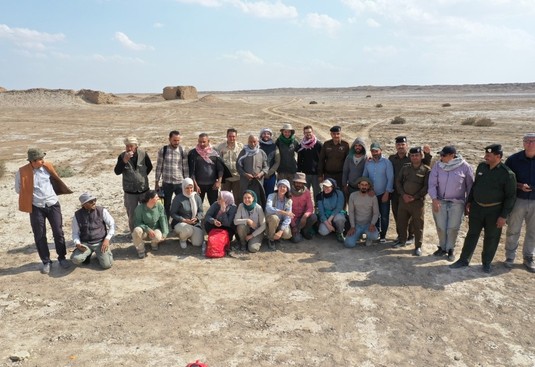FARA Fieldwork
Fieldwork in Fāra / Šuruppak
Following thorough surveys between 2016 and 2018 and magnetometer prospections in 2018 and 2022 (Team Faßbinder), first excavation campaigns were conducted in 2022 and 2024. The project is directed by Prof. Dr. Adelheid Otto (LMU Munich) in cooperation with Prof. Abbas al-Hussainy (University Al-Qadissiyah).
Research History
The excavations of the Deutsche Orient-Gesellschaft in Fāra undertaken in 1902-1903 under the direction of Robert Koldewey and Walter Andrae rendered fundamental insights into the Early Period of the Sumer Heartland, which had been almost unknown up to then. They were spectacular above all in terms of script finds, since the Fāra-tablets allowed for the first time insights into the history, economy, societey, and literature of the Early Dynastic Period, the Fāra-Period, named after this find spot.
This period, from approx. 2600-2475 BC, is equalized with FD/ED IIIa. In 1931, the University of Pennsylvania conducted further excavations, including stratigraphic sections, and Harriet Martin performed a three day's survey of the town area in 1973 (Heinrich & Andrae 1931; Schmidt 1931; Martin 1988; Krebernik 1998).
Objectives of the new Project
Despite the around 900 clay tablets from former excavations, very little understanding could be gained of the town of Šuruppak and its structure and of the various buildings and their inhabitants; so it was imperative to launch new research with state-of-the-art methods. Since the Early Dynastic levels lie directly at the surface there, Fāra offers the possibility to extensively record a town of the second large urbanization period in Southern Mesopotamia during the first half of the third millennium. The initial objective in 2022 was to clarify whether new excavations were possible and sensible in view of the massive illegal excavations: this hill was one of the most devastated ones. Furthermore - based on our results from surveying, remote sensing and geophysics - houses and official buildings should be exemplarily explored in the centre, in the lower town and at the northern fringe of the town, and geophysics should be continued. In 2024, the excavation site at the northern fringe was investigated more in depth.
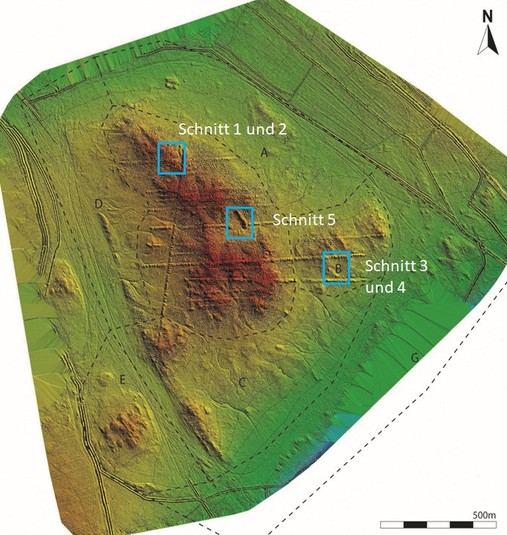
Fig. 1: Digital elevation model with the sites excavated in 2022 and 2024 (sections 1–5)
Excavations in Area I: Residential Quarters and Administrative Buildings of the FD II-III-Period
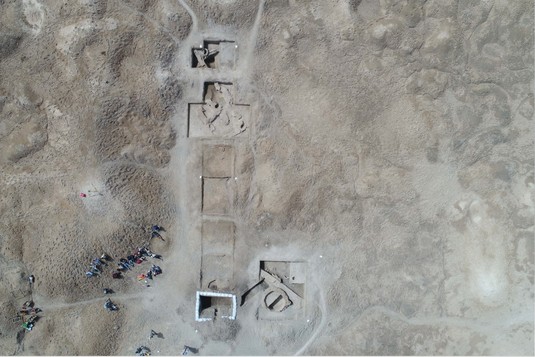
Fig. 2: View of the excavation site 1 (left) and 2 (right, with "seal pit")
In area I at the northern fringe of Fāra main hill, a 40m-section to the West was made on the basis of the "trenches Id-e" of the excavations in 1902-03. In the western part (excavation site 1), house 1 with four rooms grouped around a yard was excavated. Due to massive illegal excavations the walls and floors situated diretly at the surface are partly destroyed, so we abstained from continued excavations (Fig. 3).
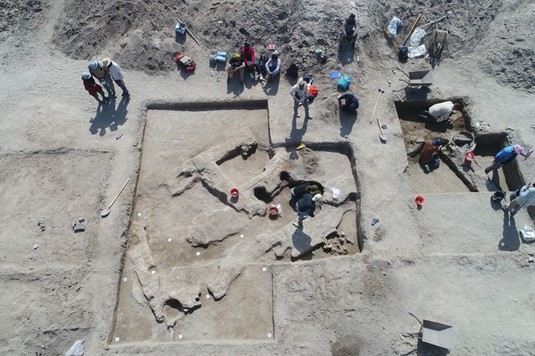
Fig. 3: House 1 during the excavations
Excavation site 2 directly borders on the „thick slag and debris levels“, where the earliest clay tablets, figurines and hundreds of sealed locks from the Mesilim-Period were found in 1902 - supposedly without evidence of "remains of residence" (Heinrich & Andrae 1931, 61). Since this is not convincing especially in terms of door locks, we searched for the building in question where the debris originated from. We indeed discovered the clay brick wall - of an exceptional thickness of 1.20m - of a building where the sloping debris levels begin; supposedly the rubbish was disposed of from this building. Adjacent to this building is a cylindrical silo made of plano-convex burnt bricks (Fig. 4).
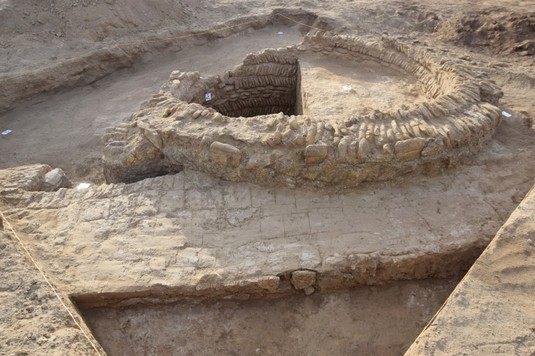
Fig. 4: The broad wall of the administrative building and the silo
The debris layers of the rubbish pit were excavated on a small area (4m long, 2.5m wide, 2.5m deep) in 2022 and 2024.
The heavily burnt debris contained huge amounts of burnt reed, shards, and animal bones, as well as dozens of figurines and hundreds of sealed locks (Fig. 5); this is why this pit was nick-named "seal-pit".
The seal images exhibit different styles, which would be identified as FD I or II, but - based on our examination of the clay material and the contexts - the locks were all made around the same time.
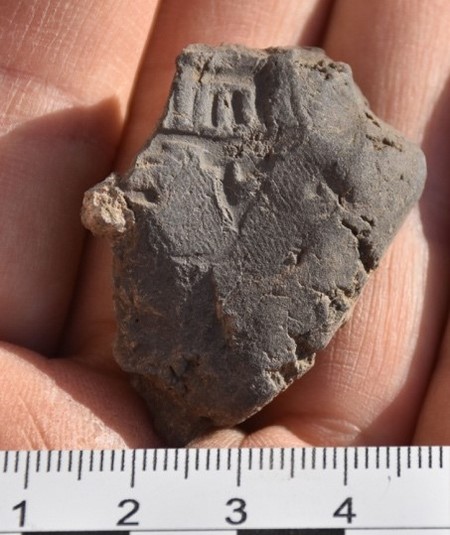

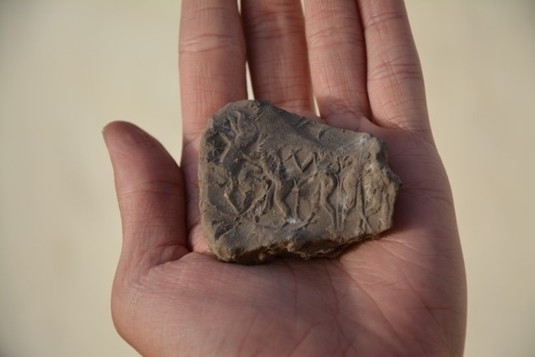
Fig. 5 a–c: Door sealings showing a drinking scene and an animal fighting scene respectively
Excavations in Area III, Slope B
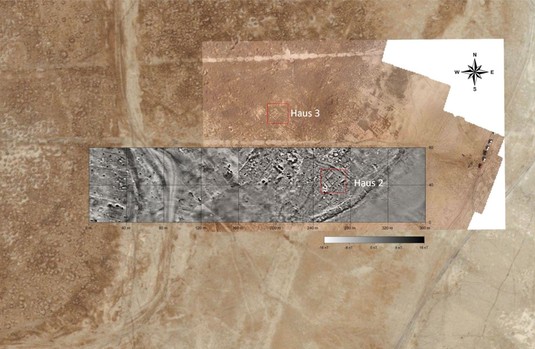
Fig. 6: Houses 2 and 3 on a drone photo and in geomagnetics (Berthold Einwag, Jörg Faßbinder)
Excavation site 3 is located east of Fāra in the direct vicinity of the city wall on slope B, which is separated from the main hill by a channel. With the help of aerial drone images after rain and magnetometer prospection, densely built residential quarters can easily be identified. Two of these buildings, ‚house 2‘ and ‚house 3‘ were excavated in 2022 (Fig. 6).
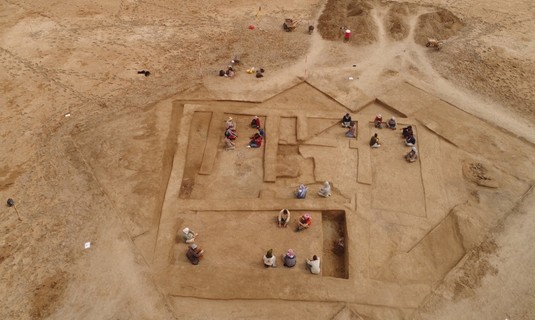
Fig. 7: House 2 after finished excavation
House 2 is a large building measuring 227 m2 with eight rooms grouped around a square yard with a hearth (Fig. 7). The walls and floors were directly beneath the surface and are not burnt. Since the sections made in 1902-03 supposedly did not hit on any structure, it is obvious that at that time adobe walls were not recognized.
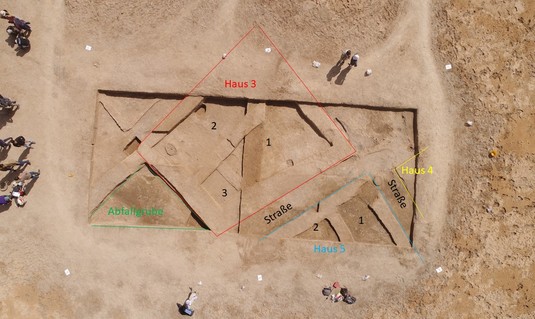
Fig. 8: The residential quarter in section 4
Excavation site 4 (19 x 9 m, 171 m2) is situated 80m north-west of excavation site 3. Overall, one almost complete building (house 3), part of a second building (house 5), and the corner of another house (house 4) were excavated. Between these houses there are roads and free spaces, burial grounds and a large rubbish pit, which contains large amounts of kitchen waste mixed with pottery with sealed closures. The pit and the houeses date to the FD IIIa-Period.
Excavations in Area II (Centre)
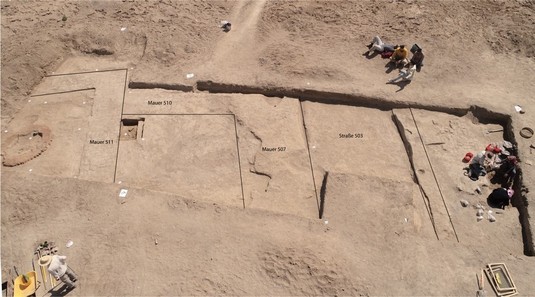
Fig. 9: The findings of excavation site 5: the outer wall of a huge building (temple?)
Excavation site 5 is situated fairly centrally on the main hill, where in 1902 in section IIIa-c an exceptional building was discovered, which already Andrae regarded as a temple (Heinrich & Andrae 1931, 12-13). Geophysical surveys in 2018 and 2022 brought to light the remains of a multi-room, more than 160m x 120m large, building that is surrounded by a 4m-broad gravel road to its west and north. In this section of 20.5m length and 6m width, the outer and inner walls of the building, the road, and the grave of an adult person and a child (tomb 502) were recorded. The finds date to the FD I-Period.
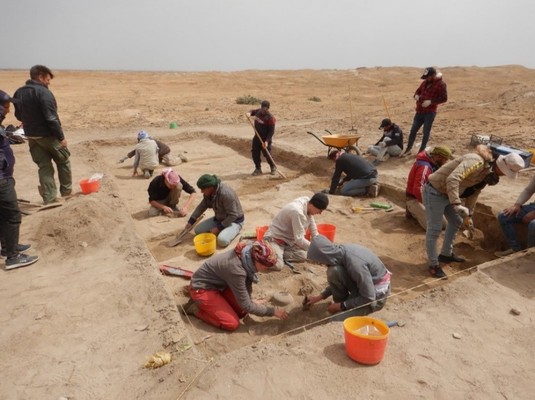
Fig. 10: Excavations in section 5, with tomb 502 in the foureground
Geophysics
In the town centre, along the city wall in the lower town, as well as at the harbour and the former Euphrates creek it was possible to carry out geophysical prospection (magnetometer), despite the disturbance by illegal excavation. Thus, hundreds of building footprints, the course of the city wall, as well as channels, harbours, and various water installation could be identified.
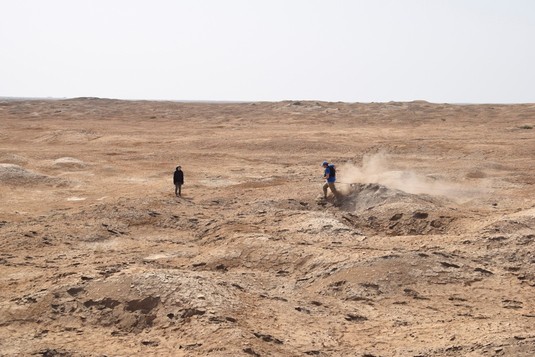
Fig. 11: Geophysics at excavation site 5
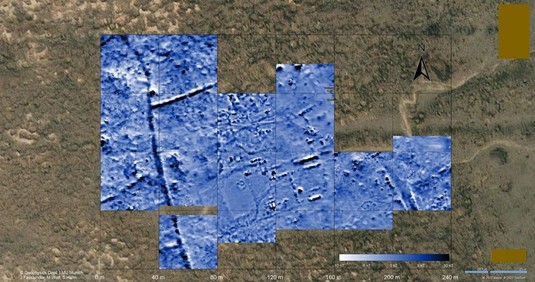
Fig. 12: Geophysical results at excavation site 5 (J. Faßbinder, M. Wolf, S. Hahn, M. Scheiblecker) 2018 and 2022: the large building in the town centre, the temple?
Team
- Archaeology (2022): Adelheid Otto, Abbas al-Hussainy and Berthold Einwag; Christoph Fink, Johannes Einwag, Johannes Hechtl, Karlotta Herbst, Jacob Jawdat, Moritz Kellerer, Le Redepenning
- Archaeology (2024): Adelheid Otto and Berthold Einwag, Cyrill Dankwardt, Darij Dubitskij, Christoph Fink, Carla Foitzik, Moritz Kellerer, Junia Kieser, Saman Sajedi, Annika Wilkening
- Drawings 2018–2024: Manfred Lerchl
- Geophysics 2018, 2022: Jörg Faßbinder, Marion Scheiblecker, Sandra Hahn, Marco Wolf
Acknowledgements
We express our gratitude to the Iraqi Board of Antiquities SBAH and its general director Ali Shalgam, as well as to the representatives of the Antiquity Offices Diwaniyah and Afak, Basim Jabbar und Haidar Laäbi. We further thank Prof. Abbas al-Hussainy (University Al-Qadisiyah), the graduate students of the Universität Al-Qadisiyah, and the Munich team for their cooperation.
We cordially thank our funders:
Faculty of Cultural Studies of LMU
Münchener Universitätsgesellschaft
Deutsche Orient-Gesellschaft e.V.
Private donators
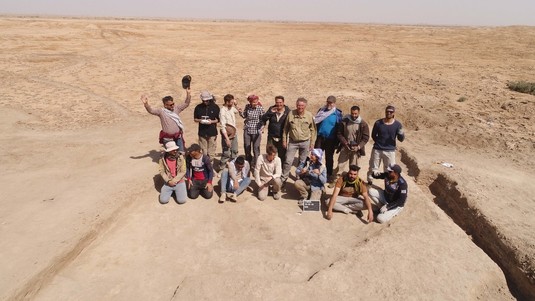
Part of the team in 2022
The team in 2024
Literature
- Andrae, W. 1903. Ausgrabungen in Fara und Abu Hatab. MDOG 17, 4−35.
- Heinrich, E. & Andrae, W., 1931. Fara. Ergebnisse der Ausgrabungen der Deutschen Orient-Gesellschaft in Fara und Abu Hatab 1902/03. Berlin 1931.
- Martin, H. P., 1988. Fara: A Reconstruction of the Ancient Mesopotamian City of Shuruppak, Birmingham.
- Schmidt, E., 1931. Excavations at Fara, 1931. University of Pennsylvania's Museum Journal 2, 193–217.
- Krebernik, M. 1998, Die Texte aus Fāra und Tell Abū Ṣalābīḫ. In J. Bauer, R. K. Englund & M. Krebernik, Mesopotamien. Späturuk-Zeit und Frühdynastische Zeit. OBO 160/1, Freiburg/Göttingen, 235–427.
Publications from the Project
- Otto, A., Fink, C., Herbst, K., Seabrook, M., Einwag, B. 2025: Neue Feldforschungen in Fāra / Šuruppak 2022 und 2024 (MDOG 2025, in print)
- Otto, A. 2025: To change, or not to change,... Transitional glyptic styles in ED II Fara / Šuruppak and their relation to officialdom (2025, in print).
- Einwag, B., Otto, A., Fassbinder, J. 2025: Harbours, Water Gates, and Canals in Šuruppak and Ur, New Results from Old Sites. In L. Romano (ed.), Sumer and the Sea (in print)
- Otto, A., al-Hussainy, A., Einwag, B., Fassbinder, J., Hechtl, J. & Herbst, K. 2024: Ausgrabungen in Fāra / Šuruppak 2022. MDOG 156, 73-104.
- Otto, A. 2023: 120 Jahre nach den Pionierleistungen der DOG: Neue Forschungen in Fāra / Schuruppak, einer sumerischen Stadt des 3. Jahrtausends v. Chr. In J. Marzahn & D. Wicke (ed.), Zwischen Schwarzem Meer und Persischem Golf. 125 Jahre Deutsche Orient-Gesellschaft. Darmstadt, 152–159.
- Otto, A. & Einwag, B. 2022: The Fāra Regional Survey Project (FARSUP) (2016–2018). In A. Otto & K. Kaniuth (ed.), 50 Jahre Vorderasiatische Archäologie in München. MAAO 7, 326–333.
- Hahn, S.E., Fassbinder, J. W. E., Otto, A., Einwag, B. & al-Hussainy, A. 2022: Revisiting Fara: Comparison of merged prospection results of diverse magnetometers with the earliest excavations in ancient Šuruppak from 120 years ago. Archaeological Prospection 29, 1–13. https://doi.org/10.1002/arp.1878
- Otto, A. & Einwag, B. 2020: The Survey at Fāra – Šuruppak 2016–2018. In A. Otto, M. Herles & K. Kaniuth (ed.), Proceedings of the 11th ICAANE, Volume 2. Wiesbaden, 293–330.
Interview with Prof. Adelheid Otto in the news magazine "Tagesschau" on 3rd May 2025
"Auf der Suche nach Noahs Arche - und was Archäologen dazu sagen" (In search of Noah's Ark - and what archaeologists have to say about this")
https://www.tagesschau.de/wissen/forschung/arche-noah-100.html?at_medium=tagesschau&at_campaign=Mail&at_content=SiteSharing
Contact
- Prof. Dr. Adelheid Otto: aotto@lmu.de
Survey in the Area around Fāra
- https://www.vorderas-archaeologie.uni-muenchen.de/forschung/fara/index.html
- https://www.vorderas-archaeologie.uni-muenchen.de/forschung/kalam/index.html
Earlier Research


